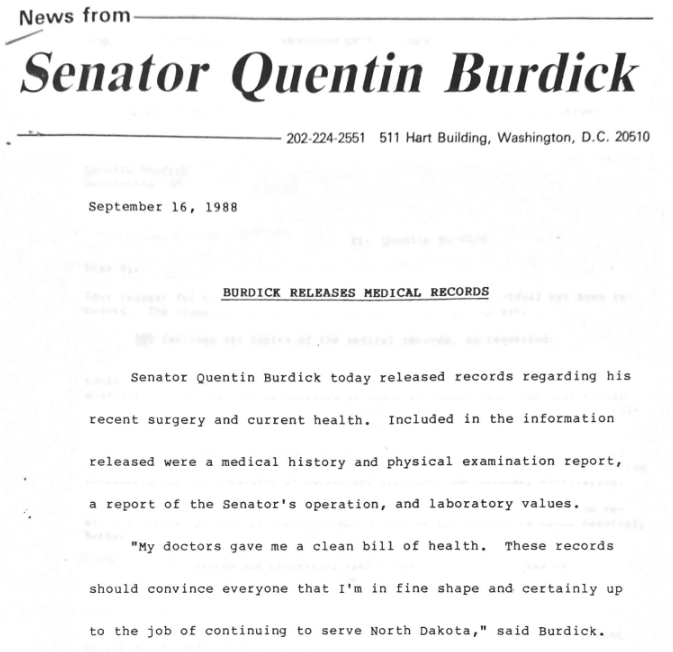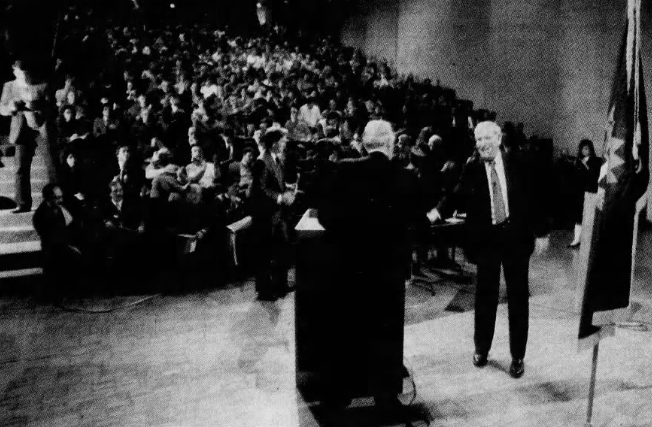Forget tax returns. RELEASE THE COLONOSCOPIES!
A common political topic these days is the rule of a Senate gerontocracy: the health of Dianne Feinstein (D-CA). Eighty-nine year-old Chuck Grassley (R-IA) winning re-election to a term that will end when he’s 95. Bernie Sanders (I-VT) will be up for re-election at age 83 next fall. Eighty-one year-old Mitch McConnell (R-KY) has taken to freezing in front of cameras but claims he’s perfectly fine.
Of course, this isn’t just a Senate problem. The presumptive nominees for president in 2024 will be 81 year-old Joe Biden (D-DE) and 78 year-old Donald Trump (R-FL). Many liberals remain adamant Ruth Bader Ginsburg should have retired from the Supreme Court while Barack Obama was president, rather than die in office. Speculation and analysis abounds: just see The Guardian or Slate.
While certainly more prevalent, it’s not a new phenomenon; the idea that aging politicos should retire and make way for a younger class of leader echoes throughout history.
What rarely happens, though, is that an aging elected official goes to such great lengths to prove they are physically fit enough to hold office. I’m not talking about Chuck Grassley doing 22 push-ups or Bernie Sanders deftly stabbing a line drive out of the air, nor do I have time for brief claims from Senate doctors that Mitch McConnell is fine.
I want to see their colonoscopies.
In August 1988, Quentin Burdick (DNPL1-ND), seeking a sixth term in the Senate, was hospitalized for an undisclosed illness that turned out to be polyps in his colon. The eighty-year-old Burdick, a veteran of the progressive Nonpartisan League who had engineered its merger with the state’s Democratic Party, was by that point no stranger to the hospital: he spent four days there the previous December for a concussion after slipping on ice at the Fargo airport. It was an open secret that Burdick’s chief of staff, David Strauss, handled much of the senator’s business; dozens of North Dakota D-NPLers had even tried to talk Burdick out of a re-election campaign in 1988, supporting a primary challenge from well-liked congressman Byron Dorgan. (Dorgan demurred…another story for another day.)
Burdick’s health became a front-and-center issue. On August 30, the Associated Press reported that in addition to having three polyps removed from his colon back in July, following his August hospitalization, Burdick had 18 inches of his colon removed at the Naval Hospital in Bethesda, Maryland.2
How he responded to concerns he was too old, though, set what I consider to be a gold standard.
First, in September 1988, Burdick’s team released his medical records. This was part of a month-long, off-and-on series of hospitalizations and medical procedures the senator underwent and, Strauss reasoned, a cover-up was impossible because of the month-long recuperation process and the risk of “trying to deceive the public,” damaging their credibility in the process. Instead, Strauss planned a series of releases to “prepare the public and put their minds at ease”: they would release a statement from the doctor reassuring folks that “the sen will be as good as new in no time,” planned ten calls to newspapers as soon as results were known to set the narrative, and even use his recover “thematically…get well, we need you, we’re pushing for you.”3
I don’t know how often we read “The patient is an 80 year old senator from North Dakota who underwent a flexible sigmoidoscopy for bright red blood per rectum approximately 2 to 3 weeks prior to admission,” but it’s not enough.4 Take a look:



As the Devils Lake Journal noted wryly, “Burdick’s battle with colon cancer, his handling of the press and his reemergence as a renewed senator have served his re-election campaign well… And Burdick didn’t have to spend a dime on political advertisements.”5
While Burdick’s challenger, Republican state representative and longtime University of North Dakota Alumni Association executive vice president Earl Strinden, opted not to make a public issue of the hospitalization right away (for exactly the “sympathy” reasons Strauss predicted), he did release his own medical records touting his fitness as an ex-Marine. But it didn’t last long: as Burdick attacked Strinden’s proposed cuts to Medicaid and other senior programs, the D-NPLer climbed in the polls despite needing to recuperate.6 It was a brilliant stroke: “I was sick and had access to good health care — imagine what would happen if you let my challenger take yours away!”
Strinden, who had long called for debates to distinguish himself from Burdick’s age, now stepped up those calls to the point of looking desperate: one Fargo Forum headline noted “Strinden pleads for debate.”7
The two clashed in an October 7 forum at the University of North Dakota, but the real fireworks game on October 28, in the second of two debates in a week’s span. After Strinden hammered Burdick and observers noted the D-NPLer’s reliance on prepared statements and notes, the Republican had a chance to make up further ground before a statewide television audience on October 28 in Bismarck.
Much of that second debate proceeded in a similar fashion, with Strinden attacking Burdick’s record and looking the part of a younger, more vital senator. But it was a final televised handshake between the two that made the second paragraph of the Bismarck Tribune story the following morning:
Burdick, 80, demonstrated his physical prowess at the end of the 30-minute debate by jerking Strinden off-balance when the 56-year-old Republican shook his hand and quipped that Burdick had done a good job reading his closing statement.
Bob Imrie, “Strinden doubts Burdick’s health,” Bismarck Tribune, October 29, 1988, 1.
“You’re damn right,” Burdick said.
Strinden played down the debate and handshake, but Burdick’s biographer gleefully quoted D-NPLers: “I’m still around and I’m King of the Hill!” recounted D-NPL governor George Sinner’s chief of staff. “The impression was he almost fell down and Senator Burdick was just grinning — sort of like — call me an old man!” recalled Agriculture Commissioner candidate Sarah Vogel.8

Were Burdick not already going to coast to re-election, those two episodes dispelled any doubt: he dismissed Strinden, 59-39.
Just a month after that victory, though, Burdick was back in the hospital following a series of seizures. Jack Zaleski of the Fargo Forum complained that the press, increasingly, was being lied to while Burdick’s health deteriorated and North Dakotans were denied adequate representation in Congress. Burdick’s aides sent reassuring press releases, and the senator resumed office in 1989 with chairmanship responsibilities in the Senate, but concerns lingered. One North Dakota journalist recalled “it was strange to see him looking like a weak old man bent like a question mark, unsteady on his feet.”9
Burdick died on September 8, 1992, back home in Fargo during a Senate recess. Sinner appointed Burdick’s widow, Jocelyn, to serve the remainder of his term under a special election could be held that December. In election-season maneuvering, Kent Conrad won the special election to fill Burdick’s seat, having previously announced he would not seek re-election to his own seat after failing on a first-term promise to balance the nation’s budget. Byron Dorgan took Conrad’s seat, and Insurance Commissioner Earl Pomeroy won Dorgan’s old seat. D-NPLers continued to hold all three of North Dakota’s congressional spots, ushering in an era of “Team North Dakota” in Congress.
In alternate timelines, perhaps Democrats wouldn’t have been so lucky: Burdick’s death came as D-NPL power in North Dakota was still high, though waning. His and his team’s response to questions of his age, though, both reflected Burdick’s longstanding Nonpartisan League populism and his own personal fortitude in office. With a stable of North Dakota D-NPL candidates behind him, though, his 1988 Senate campaign ought to serve as model and warning for questions of “How old is too old?”
Notes
1 The North Dakota Democratic-Nonpartisan League Party (D-NPL) was formed in 1956 by the merger of a progressive and historically-Republican insurgency that acted like a third party, the Nonpartisan League, with the Democratic Party. Quentin Burdick played a large role in that merger.
2 Associated Press wire, “Burdick’s tests show no further cancer,” Bismarck Tribune, August 30, 1988, 1A.
3 David Strauss, handwritten notes c. August 1988. Quentin Burdick Papers, Box 659. Elwyn B. Robinson Department of Special Collections. Chester Fritz Library. University of North Dakota, Grand Forks. Hereafter “Burdick Papers”; “Burdick staff denies covering up health issue,” Fargo Forum, August 31, 1988, C1.
4 Press release, “Burdick undergoes intestinal surgery, doctors call precautionary operation a complete success,” August 25, 1988,” 1; Press release, “Burdick releases medical records,” September 16, 1988, 1. Burdick Papers, Box 659.
5 Editorial, “Burdick’s recovery serves him well,” Devils Lake Journal, September 8, 1988, 4. See also Tubby Harrison to David Strauss, “North Dakota Senate Race–General Election Poll #5,” September 14, 1988. Burdick Papers, Box 658.
6 AP wire, “Strinden’s physician says candidate ‘healthy ex-Marine,'” Bismarck Tribune, September 17, 1988, 5B; Shannon Bradley, “Strinden’s Chance To Unseat Burdick Is Slipping Away,” Roll Call, October 2, 1988, 8; Dan Rylance, Quentin Burdick: The Quiet Warrior (Fargo: NDSU Institute for Regional Studies, 2007), 303.
7 “Strinden pleads for debate with Burdick,” September 24, 1988, Fargo Forum, C6.
8 Rylance, 305-306; Bob Imrie, “Strinden doubts Burdick’s health,” Bismarck Tribune, October 29, 1988, 1A.
9 Patrick Springer, “Senator’s condition upgraded; may be released in a week,” Fargo Forum, December 2, 1988, B1; Jack Zaleski, “Burdick’s health is a tough issue for journalists,” Fargo Forum, December 4, 1988, C5; Press release, “Senator Burdick released from hospital,” December 9, 1988. Burdick Papers, Box 659; Rylance 318-319.

